- Home
- J. -H. Rosny aîné
Vamireh
Vamireh Read online
The Scientific Romances of
J.-H. Rosny Aîné
VAMIREH
And OtherPrehistoric Fantasies
translated, annotated and introduced by
Brian Stableford
A Black Coat Press Book
Introduction
This is the fourth volume of a six-volume collection of stories by J.-H. Rosny Aîné (“the Elder”), which includes all of his scientific romances, plus a number of other stories that have some relevance to his work in that genre.1
The contents of the six volumes are:
Volume 1. THE NAVIGATORS OF SPACE AND OTHER ALIEN ENCOUNTERS: The Xipehuz, The Skeptical Legend, Another World, The Death of the Earth, The Navigators of Space, The Astronauts.
Volume 2. THE WORLD OF THE VARIANTS AND OTHER STRANGE LANDS: Nymphaeum, The Depths of Kyamo, The Wonderful Cave Country, The Voyage, The Great Enigma, The Treasure in the Snow, The Boar Men, In the World of the Variants.
Volume 3. THE MYSTERIOUS FORCE AND OTHER ANOMALOUS PHENOMENA: The Cataclysm, The Mysterious Force, Hareton Ironcastle’s Amazing Adventure.
Volume 4. VAMIREH AND OTHER PREHISTORIC FANTASIES: Vamireh, Eyrimah, Nomaï.
Volume 5. THE GIVREUSE ENIGMA AND OTHER STORIES: Mary’s Garden, The Givreuse Enigma, Adventure in the Wild.
Volume 6. THE YOUNG VAMPIRE AND OTHER CAUTIONARY TALES: The Witch, The Young Vampire, The Supernatural Assassin, Companions of the Universe.
The first volume of the series includes a long general introduction to Rosny’s life and works, which there is no need to repeat here; the following introduction will therefore be limited to a brief account of the stories included in this volume, which will be supplemented by a more detailed commentary contained in an afterword.
Vamireh first saw print as a serial in the Revue Hebdomadaire in 1892, and was reprinted in book form by Kolb the same year. Rosny made no reference in his memoir Torches and lumignons to any prehistoric fiction in the list of projects he recalled working on in 1885, before making his first bid for publication with Nell Horn, but Vamireh represented such a stark departure from the pattern of his other publications that one is bound to suspect that it might have been written much earlier than its publication date. On the other hand, it is possible that he had been inspired to produce it by the sensational discovery in 1891 by the Dutch scholar Eugène Dubois of fossil human remains in Java—where Dubois, convinced that humans must have originally evolved in the tropics, had gone to specifically look for them, joining the Dutch army in order to obtain a posting there.
Dubois’ discovery seemed to many observers to put the final nail in the metaphorical coffin of stubborn adherents to Biblical chronology, who maintained that all the evidence of “prehistoric man” found in Europe was either misleading or of sufficiently recent origin to be accommodated to Biblical chronology. Rosny, a determined evolutionist, must have been delighted by the discovery of what he initially assumed to be a specimen of the long-hypothesized “ape-man” Anthropopithecus (although Dubois preferred the appellation Pithecanthropus erectus, and subsequent taxonomists eventually reclassified his “Java man” as Homo erectus). Whether Vamireh was written as a response to Dubois’ discovery or had been begun long before, it was almost certainly the publicity given to the discovery that encouraged its publication. Rosny followed it up rapidly with Eyrimah, which was serialized in the first five issues of Le Bambou in 1893 and then reprinted in the Revue Hebdomadaire in 1896, before being reissued in book editions by Chailley and Plon—a success suggesting that the earlier work had been well-received, or at least considered very timely.
Further evidence of the success of Vamireh was provided when Rosny produced an abridged version of it for publication in an illustrated edition in 1896 as Elem d’Asie. Significantly, the abridgement disposed of much of the “background” material that Rosny had inserted in order to construct a broad image of the prehistoric setting, in order to concentrate on the story, which is a combination of a love story and an adventure story. The story in question partially inverts a formula that Rosny used in many of his adventure stories, in which the plot is moved by the abduction by savages of the hero’s inamorata; in this instance, the hero is the initial abductor, and it is not until his pursuers recapture the prize that the tables are turned and he sets out to recover her. A similar inversion is featured in Eyrimah, where the narrative focus eventually settles on a male abductor and his pursuit, having started out as the story of the eponymous runaway slave.
The success of these two romans préhistoriques appears to have been brief, to begin with, not extending much beyond 1896. Indeed, the short story “Nomaï,” which first appeared in the Revue Parisienne in 1895, represents a wry recantation of the assumptions made in the earlier stories, based on new thinking that Rosny had apparently developed in the course of writing a non-fictional essay on paleoanthropology, Les Origines (Borel, 1895). Both the essay and the short story flatly contradict one of the central assumptions of the earlier stories—a contradiction that was taken for granted in all Rosny’s subsequent images of primitive humankind. For whatever reason, though, Rosny wrote no further romans préhistoriques for more than a decade, only returning to the genre after the pseudonym had been redivided, the two brothers who had been sharing it having decided to go their separate ways.
Once J.-H. Rosny Aîné had resumed his own literary identity, he made a concerted attempt to begin selling adventure stories to the new middlebrow magazines that had sprung up in imitation of the English Strand Magazine, and he eventually produced three more long romans préhistoriques in this context: La Guerre du feu (1909 in Je Sais Tout; reprinted in book form 1911; tr. as The Quest for Fire), Le Félin géant (1918 in Lectures Pour Tous; reprinted in book form 1920; tr. as The Giant Cat and Quest of the Dawn Man) and Helgvor du fleuve bleu (1930; tr. as Helgvor of the Blue River). The three stories included here do, in any case, form a distinct group.
Rosny was not the first French writer to produce romans préhistoriques; he had been preceded by Samuel Berthoud, author of Aventure des os d’un géant, histoire familière du globe terrestre avant les hommes [The Adventures of the Bones of a Giant: A Family History of the Pre-Human World] (1862) and L’Homme depuis cinq mille ans [Five Thousand Years of Man] (1865), and Elie Berthet, author of Le Monde Inconnu (1876; rev. as Paris avant l’histoire; tr. as The Pre-Historic World, 1879). When Rosny was first hailed as a French anticipator of H.G. Wells, however—which also occurred in 1896, when a volume entitled Le Cataclysme was issued, containing the story previously known as “Tornadres” (1888; tr. in vol. 3 as “The Cataclysm”) and “Les Xipéhuz” (1887; tr. in vol. 1 as “The Xipehuz”)—the fact that he and Wells had both written prehistoric fantasies was recruited as further evidence of their supposed kinship. Even so, it was not until the publication of La Guerre du feu that Rosny’s contribution to the subgenre was deemed particularly significant; numerous other writers had contributed to it in the meantime, but none as effectively. Once La Guerre du feu had become established as a key work in the subgenre, however, Rosny’s earlier prehistoric fantasies came to be considered an important, if subsidiary, component of his oeuvre.
A significant analysis of Rosny’s contribution to the subgenre was published in the Mercure de France in 1923 as “J.-H. Rosny et préhistoire,” by Jean Morel and Pierre Massé.2 The authors mention that other significant French contributions to the subgenre had been made by Remy de Gourmont, Edmond Haraucort, Pierre Louÿs and Pierre Mille (without naming the specific examples, which are decidedly peripheral in the cases of Gourmont and Louÿs), but rightly contend that Rosny’s were more important as well as more prolific. More importantly, Morel and Massé attempt to analyze the sources on which Rosny drew, identifying three of particular significance: the Fren
ch translation of Sir John Lubbock’s Prehistoric Times (1865)—as L’Homme préhistorique (1876)—Nicolas Joly’s L’Homme avant les métaux (1879) and Gabriel de Mortillet’s Le préhistorique (1882).
Of the three authors cited, the one who seems to have had the greatest influence on Rosny was Mortillet—understandably, given that he was by far the most successful French popularizer of paleoanthropology and founded the first French journal dedicated to the science, Le Musée préhistorique, in 1881. Mortillet—a colorful character who had been exiled from France for many years in the aftermath of the 1848 revolution, which he had helped to prompt—had embroiled himself fervently in the controversies surrounding the antiquity of humankind following his return to Paris in 1864, inevitably weighing in on the side of those who opposed Biblical chronology, and contended that rapidly-accumulating paleontological evidence proved that human evolution extended back over tens of thousands of years into what geologists called the Tertiary period. He produced an influential categorization of the phases of human evolution through the Stone Age, based on variations of stone tools found at various (mostly French) sites, the five phases in question being identified as the Chellean, the Mousterian, the Solutrean, the Magdalenian and the Robenhaussian; this is the terminology that Rosny adopted in his prehistoric fantasies.
Morel and Passé observe that Rosny’s image of prehistory remained anchored in the popularizations of the early 1880s, never progressing beyond the authors of the “period of enthusiasm” to take in the subsequent modifications made to Mortillet’s theories by subsequent paleoanthropologists such as Emile Cartailhac, Salomon Reinach and Alexis Bertrand. They do not infer from this that Rosny might have begun writing Vamireh in the early 1880s, while he was still living in England, but they do observe that the notion that there were several distinct species of humans extant in the Tertiary Era—which is so elaborately developed in Vamireh and played a significant role in many of Rosny’s subsequent prehistoric romances and lost land stories—is an extrapolation of Mortillet’s contention that there were three species of Tertiary “anthropopithecines,” and the rather fanciful descriptions that he gave of them. (The controversial European specimens of fossil humans included several that were later to be gathered together as examples of “Neanderthal Man,” but which still remained open to various imaginative interpretations in 1882.)
The other theories espoused by Rosny in his early prehistoric fantasies are credited by Morel and Massé to sources prior to Mortillet, as cited by him or by Joly. They credit the popularization of the thesis that an indigenous fair-haired European race had been defeated in war by better-armed dark-haired invaders from the East to the Broca Conference sur les troglodytes de la Vézère held in 1871, and the identification of the invading race with the “Aryans” hypothesized by linguistic theorists—in which they find the origin of the “Ariès” featured in Eyrimah—to Adolphe Pictet's Les Origines indoeuropéennes ou les Aryas primitifs (1859-63; reprinted in 1877). They suggest that the notion of secret metallurgists, similarly reproduced in Eyrimah, was probably drawn from Frédéric de Rougemont’s L’Age du bronze ou les Sémites en Occident (1866).
Morel and Massé have less to say about the nature of Rosny’s evolutionist ideas, although they do observe that he shows no considerable understanding of the ideas of Charles Darwin, despite his frequent use of the notion of “selection” and his incessant references to the inherent tragedies of the struggle for existence. Morel and Massé suggest that this might be because Rosny derived his evolutionist ideas from the writings of Carl Vogt, but that seems highly unlikely, and his true allegiance seems to be to the transformist theories of the Chevalier de Lamarck. When he wrote his early prehistoric romances, Rosny could not have had any inkling of the impending development by Henri Bergson of the quasi-Lamarckian idea of élan vital, which plays a crucial role in Bergson’s concept of L’Evolution créatrice (1907; tr. as Creative Evolution), but he seems to have developed a notion very similar to it on his own account, which is vaguely sketched out in “La Légende sceptique” (1889; tr. in vol. 1 as “The Skeptical Legend”) and tacitly underlies the great majority of his scientific and prehistoric romances.
I shall comment further on these points in the afterword, when I shall also offer my own commentary on the nature and imaginative sources of the three stories translated herein. One further matter that warrants comment in advance, however, is that neither Rosny nor any of his sources was able to rely on an accurate time-scale for the sequential events they described, their work being far in advance of the radioactive dating techniques that now permit a sophisticated calibration of the record revealed by paleontological and archaeological excavations. Rosny is therefore compelled to talk rather vaguely in terms of thousands or tens of thousands of years—figures which become much vaguer as they are occasionally extrapolated into even remoter regions of the past recorded by fossil remains. Although his imaginative reconstructions work on a more generous scale than Biblical chronology, therefore, they do not do justice to the actual antiquity of human and proto-human evolution—a failing for which he cannot be held accountable.
The version of Vamireh that I used for translation is a Plon reprint issued in 1926. The version of Eyrimah that I used is also a Plon reprint, issued in 1938. The version of “Nomaï” that I used is the one that appeared in the Plon collection Un Autre Monde, issued in 1898. I have no reason to think that any of these versions differs significantly from the original versions, or from any others.
Brian Stableford
VAMIREH
A Romance of Primitive Times
I. The Bellicose Night
Twenty thousand years ago, the North Pole was orientated toward a star in Cygnus. On the plains of Europe the mammoth was about to become extinct, while the emigration of the large wild beasts toward the Land of Light and the northward flight of the reindeer were coming to an end. The aurochs, the urus and the red deer were grazing forests and savannahs. The colossal cave-bear had perished in the depths of its caverns a long time ago.
In those days, the men of Europe, the tall dolichocephali,3 extended from the Baltic to the Mediterranean, from the West to the East. More reclusive cave-dwellers than their ancestors of the Solutrean Age, but still nomadic, their technology was already advanced and their art sensitive. Sketches traced with frail chisels, timidly but faithfully, were the brain’s struggle toward dreams, against the brutality of appetites. Later, when the Asiatic invasion came, art died out and that charming employment was only recovered after a long interval.
In south-eastern Europe, in the season of renewal, with the night two-thirds gone, the voices of carnivorous beasts were resounding in the ash-gray light of a large valley. In the intervals of silence, a river sang the life of fluids, the euphony of waves; the alders and poplars replied in whispers and intermittent harmonies. The star Venus was rising in the east. The procession of the immortal constellations was visible between the vagabond clouds. Altair, Vega and the Plough were rotating around the pole star in Cygnus.
While ferocious or fearful life palpitated in the darkness, hurrying to the celebrations and battles of love or nourishment, a thinking mind joined in. On the bank of the river, on the edge of a solitary rock, a silhouette emerged from the Humans’ cave. He stood there, still and attentive, sometimes looking up at the Star of the East. Some vague dream or inkling of astral esthetics preoccupied the watcher, less rare among these ancestors of Art than many historical populations. His veins throbbed with robust health; the nocturnal breeze charmed his face; he enjoyed the rumors and clams of virgin nature fearlessly, in the full consciousness of his strength.
Meanwhile, a delicate light appeared beneath the star Venus. The boomerang of the Moon appeared, its radiance expanding over the river and the trees, dappled with long shadows. Then the form of the tall hunter, his shoulders covered with an urus-pelt cloak, stood out more clearly. His pale face, painted with lines of red lead, was broad beneath his deep and combative skull. His horn-p
ointed spear hung obliquely from his back, and in his right hand he was holding a massive oak-wood club.
At the touch of the moonlight, the landscape seemed less grim. There were white wings fluttering among the poplars; paradisal corners could be glimpsed on the plain; there was a visible general palpitation, a timid protest against the ferocities of darkness. Even the voices diminished, the battle raging less ardently in the nearby forest, where the wild beasts’ appetites for sex and blood were satiated.
Weary of immobility, the man walked along the river at the lithe pace of a hunter. After 500 meters he stopped, poised, his spear held ready at head height.
An agile silhouette appeared at the edge of a grove of maples: a red deer with ten-point antlers. The hunter hesitated, but the tribe obviously had abundant provisions of meat, for, disdaining the pursuit, he watched the animal move away on its slender legs, with its head thrown back, the entirety of its beautiful body, designed for running, launched into the reddish gleam.
“Llô! Llô!” he said, not without sympathy. His instinct anticipated the approach of a predator, some powerful cat on the prowl. Indeed, half a minute later, a leopard emerged from behind the troglodytes’ rock, launching itself forward with lightning speed in immense bounds. The man got his spear and club ready then, attentively, sniffing the wind with his nerves in tumult. The leopard passed by like foam on the river, soon disappearing from sight. The hunter’s delicate ears perceived its course over the soft earth for several minutes more. “Llô! Llô!” he repeated, slightly excited, striking an arrogantly challenging pose.
Minutes went by; the horns of the crescent moon were already clearer. Small creatures were brushing through the bushes on the river-bank; large frogs were croaking amid the water-plants. The man savored the simple sensuality of living beside the luxury of open waters, and the play of shadows and light; then he moved on again, his ears pricked, his eyes—accustomed to the semi-darkness—on the lookout for nocturnal ambushes. “Hoï?” he murmured, in an interrogative tone, as he took refuge in the shadow of a bush.

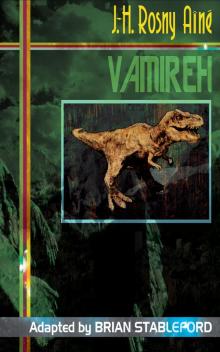 Vamireh
Vamireh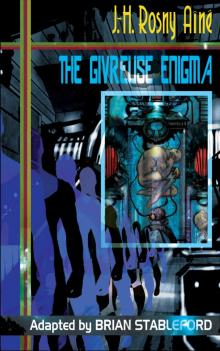 The Givreuse Enigma
The Givreuse Enigma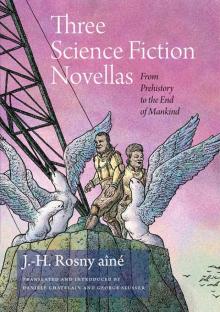 Three Science Fiction Novellas: From Prehistory to the End of Mankind
Three Science Fiction Novellas: From Prehistory to the End of Mankind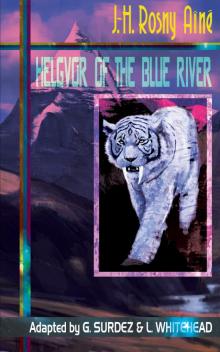 Helgvor of the Blue River
Helgvor of the Blue River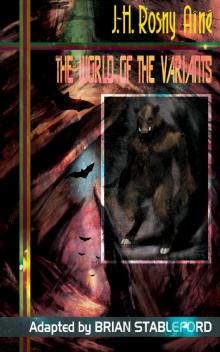 The World of the Variants
The World of the Variants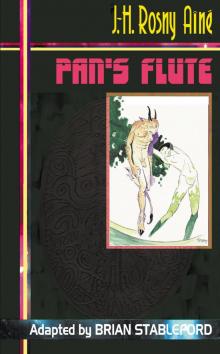 Pan's Flute
Pan's Flute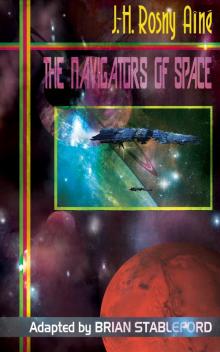 The Navigators of Space
The Navigators of Space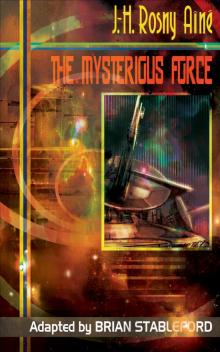 The Mysterious Force
The Mysterious Force